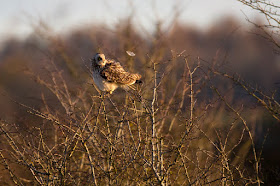 |
| Male Sprawk (c) JR |
The folk origins of Valentine’s Day arose
through the belief that it was on this day in February that wildlife,
especially the birds, chose their mates for the year. Although we know that
this is just an old wives’ tale there was much more evidence that courtship and
display was getting going. The cold grey sleet and strong winds of Saturday
gave way to sunshine and a chilly start on Sunday and it was on Sunday, St
Valentine’s Day itself, that this “choosing” was most evident.
 |
| Valentines Swans (c) Bark |
As I arrived a Song Thrush was singing lustily
from the blackthorn in the carpark field and where I heard just one Chaffinch
singing last weekend, on this Sunday I heard at least ten, spread out across
the reserve. Skylarks were performing aerial displays above Greenaways and
chasing each other across the sky. Great Tits and Dunnocks were also starting
to sing more noticeably. Over the reedbed the resident pair of Marsh Harriers
were reinforcing their pair bond flying together and simulating a food pass
almost locking talons.
The skies were again dominated by huge numbers
of Lapwings and Golden Plovers. My impression was of more Goldies than Lapwings
but the birds were so spread out and flushed so often that it is very difficult
to estimate accurate numbers. As the morning drew on they gradually became less
nervous and flighty and flushed less frequently. They have been feeding on the
Noke sides Fields and while there it is possible to go through them carefully
and look for an American cousin. Sadly, none was found on Sunday but with such
large numbers of birds it is quite possible that there might be an odd one,
after all it happened twice on Port Meadow!
Another sign of the advancing season was the
first returning Redshank found on Thursday morning, as we move towards March so
their numbers will increase and we can also expect the first Curlew to arrive
any time soon.
 |
| Sparrowhawks (c) Norman Smith |
Although much reduced from its earlier numbers
the Starling roost is still impressive and one of the reasons why we still
attract lots of raptors to the reserve. It is easy to find the “walking
wounded” feeding on the grassy edges and adjacent hedgerows during the day
time. Unable to fly properly they scuttle off into the longer grasses and
bushes as you come across them. It is inevitable that there will be casualties
and ailing individuals and they offer an easy meal to both avian and mammalian
predators alike.
As I have reported before, the winter seed
feeding beside and to the south of the hide is proving again to be a great
success. It provides food at a critical time for birds that rely on small seeds
and weedy field margins, which are a fast disappearing resource. There is a
“hungry gap” for seed eaters that extends into spring before the first weeds
set seed and also those winter months when finding food is more difficult. We
are now attracting over two hundred Linnets, well over a hundred and fifty Reed
Buntings, Chaffinches, Goldfinches and this week twelve Yellowhammers, a bird
that has been much scarcer on Otmoor since there has been a decline in arable
farming in the area. It has also attracted Mallards, Wood Pigeons, Moorhens,
five Stock Doves, assorted Rooks and Jackdaws and of course a pair of Sparrowhawks.
So much available food will as everywhere else inevitably attract raptors. The
male Sparrowhawk will often pause for a while right next to the hide on the
fence, as it did on Saturday, offering superb views.

 |
| Taking advantage of the seeds (c) Bark |
Out on Greenaways there are at least two pairs
of Stonechats and another pair were found over on the Oddington side on Sunday.
Bitterns are being seen regularly but as yet not a single boom has been heard.
Over the next week we will be listening out for it and also for the first
returning curlews.
 |
| Chilly Robin 9c) Bark |




















